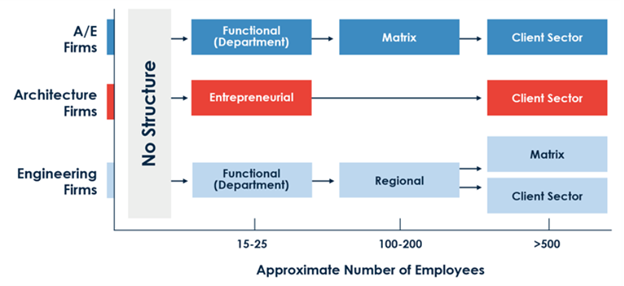When firms are just starting, they need clients, key staff, and start-up capital. The last thing they need is an org chart!
As they grow, they find that the lack of a formal structure creates a lot of confusion. So, as they grow, AE firms generally organize themselves as shown below.

But the most common practices aren’t always the best. While most large firms are organized by market sector, one of the best-performing firms in our industry, Kimley-Horn, has held onto a regional organization as they have grown to over 10,000 employees nationwide. How successful is Kimley-Horn?
Here are a few statistics:
-
They have averaged roughly 20 percent per year revenue growth for nearly 10 years.
-
Their financial performance has put them in the PSMJ Circle of Excellence for 13 years in a row.
-
They have been on the Fortune Magazine list of “Best 100 Firms to Work for” for 18 years. Most recently, they were ranked Number 22 in the nation and were the only AE firm to make this prestigious list.
While most large AE firms try to consolidate local offices, Kimley-Horn takes the opposite approach. They are so locally focused that they now have over 130 offices across the United States, including multiple offices in the same metro areas.
Aaron Nathan, Kimley-Horn’s COO, recently shared a story with me that exemplifies the company's philosophy of focusing on local markets. They needed to expand the office space in their Dallas Galleria office, but no space was available in the building. When discussing where to expand, some observed that they’d be better off adding offices in different parts of town rather than looking for one office location for all employees in the Dallas area. Which is what they ended up doing – they kept their Galleria location and also opened a new office in Richardson, an adjacent community. This continued a strategic approach for how Kimley-Horn focuses on being local in large markets as well as providing leadership opportunities to their people. Kimley-Horn has found that staying local gives them better access to both clients and employees in those areas. Today, nearly 1,000 K-H employees in the DFW area are spread across 12 different offices.
So how should you organize your firm? A major consideration is your strategy for attracting and keeping clients. In Kimley-Horn’s case, they complement their technical expertise with a strong focus on being local – knowing the geography, regulatory environment, politics, etc. This local focus has led them to a regional organizational structure.
Here are some guidelines to consider for your firm:
-
Your structure must consider all three “dimensions” of a market – geographic, client sector, and technical expertise. Select one of these as your line organization that houses your business units.
-
If you want to maintain a strong local focus (like Kimley-Horn), organize geographically.
-
If you want to focus more on technical expertise, organize by discipline or technical specialty.
-
If you want to focus on really understanding how your different client sectors operate, organize them by client sector or market sector.
-
Whichever “dimension” you choose as your business units, support it with a strong emphasis on the other two. For example, although Kimley-Horn’s business units are geographical, they also provide strong support in their areas of technical expertise and in the knowledge of the markets they serve.
One last thought about organizational structure, courtesy of Chuck Howland, one of the founders of CH2M-Hill: “Any organizational structure will work if everyone wants it to.” Unfortunately, the corollary is also true: No organizational structure will work if everyone is in it just for themselves.
This is content from the PSMJ Newsletter, exclusive to PSMJ PRO Members. PSMJ PRO is the fastest-growing network of AEC firm leaders. Not a PRO Member? Try a 50-day trial (no credit card required). You can request a trial here: https://www.psmj.com/50daylite


